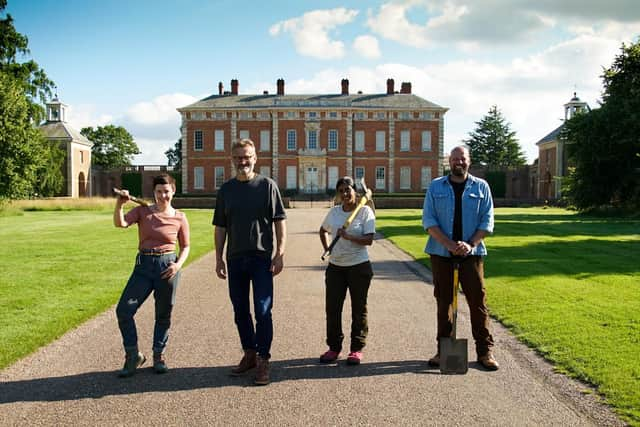Largest chicken bones ever found in England unearthed in Yorkshire during The Great British Dig
If there’s one thing that archaeologists were likely to find when they were tasked with excavating burials that were part of an early medieval cemetery, it was bones.
What they didn’t quite anticipate, however, was unearthing the largest chicken bones to ever be recovered from an archaeological dig in England.
Advertisement
Hide AdAdvertisement
Hide AdThe discovery was made by the team from TV show The Great British Dig as they worked to learn more about what sits beneath modern day Masham in the heart of North Yorkshire.


It is just one of the finds that features in a new book, tied to the show, by on-screen expert Dr Chloë Duckworth. “We found these bones but didn’t realise at the time that we had anything special,” she says.
It was only after the excavation when find specialists were studying the material found at the site that the full extent of what they’d recovered was revealed.
A large number of animal bones had been unearthed in the search but the chicken ones stood out because of their size. They are consistent with a breed known as the Brahma Chicken, large birds that were brought into the UK in the 19th century.


Advertisement
Hide AdAdvertisement
Hide AdNone of the bones showed any sign of butchery, suggesting the birds weren’t for eating. Instead it’s thought they were kept as pets or for showing.
“We reckon this is someone who is reasonably wealthy in a country setting who has got these fancy birds for showing at fairs,” Duckworth muses. “You can just imagine this local person a couple of hundred years ago with their fancy chickens taking them off to show them.”
“It was a really cool find,” she adds. “And it also highlights why we don’t stop when we take stuff out of the ground, we keep studying it.”
Duckworth, a lecturer in Archaeology at Newcastle University, is one of the expert presenters of the Channel 4 show, which sees the team excavate back gardens around Britain and explore the fascinating objects that lie beneath them.
Advertisement
Hide AdAdvertisement
Hide AdHer book, The Great British Dig: History in Your Back Garden, features every dig from both the first and second series. The archaeological detective work sheds light on places all over the country, from a secret prehistoric village under a school playing field to a Victorian prison and a Tudor palace, helping to reveal how people once lived.
Duckworth, who lived in Hull until the age of seven, says the team worked with a professional archaeological company to identify potential sites of interest. “We ended up actually with two sites in the North East and two sites in Yorkshire out of the ones that have aired so far and that’s really good as I don’t think the North gets represented enough.”
In Masham, the team’s focus was on a cemetery dating back to between the 7th and 11th centuries. The burial site was first discovered during plumbing works in the late 1980s and the remains of more than 50 individuals were excavated.
By digging the gardens of local residents, the team now hoped to learn more about the size of the cemetery and how many burials may still lie beneath the streets.
Advertisement
Hide AdAdvertisement
Hide Ad“That was a really special dig because we don’t normally go looking for burials to be honest, especially not in the context of the show,” Duckworth says. “But that cemetery had been discovered during work in the 80s and it’s just incredible.
"There are all these people who lived a thousand or more years ago, it’s the era when you have Vikings raiding the coast and some choose to settle and marry local people. You’re looking around thinking I wonder if their descendants are still kicking about here today?”
A reconstruction image was created of one of the skeletons, which was found under a pub garden. “It brings home how just a few feet below you, there could be an incredible piece of history that no one even realises,” Duckworth says.
Over at Beningbrough Hall outside York, the team had a rather different brief - to help shed some light on the original gardens of the stately home.
Advertisement
Hide AdAdvertisement
Hide AdCombining different techniques including using drawings, paintings and photographs of the site alongside surveying, coring and excavation work, they were able to provide insight into the design and layout of the house’s original 17th century gardens. It was a favourite for Duckworth, though at first, she admits she wasn’t convinced.
“I have to confess when we saw the longlist of sites and all the possibilities of where we might go, I thought I don’t want to dig a garden to find a garden...But to be honest it was one of my favourite digs in the end.”
The landscape surrounding the hall that visitors to the site see today is the result of a programme of remodelling in the 19th century. “When you visit these properties, you don’t really think that they don’t look the way they used to look, quite often they look the way Victorians made them look,” Duckworth says.
“Victorians liked big open landscapes but actually when these gardens were first built, they were supposed to look like little Italian gardens with lots of paths and little water features. What I really loved about this one was that the gardens were so important, you can’t look at the house in isolation. The gardens were where people did so much of their socialising.”
Advertisement
Hide AdAdvertisement
Hide AdIn the book, Duckworth explores the team’s techniques in detail and offers behind-the-scenes insight into how digs were carried out and discoveries made. There’s also practical tips and advice for anyone wanting to have a go themselves.
“I hope it will get people engaged with archaeology who might be interested but might not have realised it’s an option for them,” Duckworth says. “You don’t have to be a professional archaeologist to be involved with it. I also hope it makes sure people do that in a way that’s legal and safe.
“I’d like it to remind people that archaeology is a really positive thing and it’s something we do really well in the UK. We’ve got a really good professional archaeology sector in this country and it’s the envy of a lot of other nations.”
It’s important, she says, for the ordinary person to be able to access archaeology “because’s it’s about us, it belongs to everyone”.
Advertisement
Hide AdAdvertisement
Hide Ad“History is wonderful but it reflects what people chose to write down and who they chose to write about,” she continues. “We know that people get written out of history, people who are considered less important at the time, and that’s often ordinary people, the elderly, women, kids.
“Archaeology’s beauty is that it’s kind of accidental - no one is putting rubbish in a tip in their garden in the 19th century hoping that someone will dig it up years later. And what that does mean is it’s about everybody.”
The Great British Dig: History in Your Back Garden by Dr Chloë Duckworth is published by Conway and is out now (Hardback, £25.00)
Support The Yorkshire Post and become a subscriber today. Your subscription will help us to continue to bring quality news to the people of Yorkshire. In return, you'll see fewer ads on site, get free access to our app and receive exclusive members-only offers. Click here to subscribe.
